
Common name:Boston Ivy
Botanical name:Parthenocissus tricuspidata
This semi-evergreen vine has dark green leaves that are usually lobed and divided into 3 leaflets. Clings with both tendrils and adhesive-like tips that cements itself to all manner of surfaces. Leaves turn orange or red in autumn. Flowers are inconspicuous. During fall, small blue black berries appear to the delight of birds. This vine can grow 50'-60' long but it really depends on what it is growing on. This vine is aggressive.
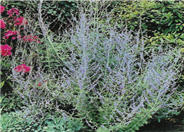
Common name:Blue Spire Russian Sage
Botanical name:Perovskia 'Blue Spire'
'Blue Spire' is a selection of perovskia that grows about 3 to 4 feet tall and 2 to 3 feet wide (though it will grow larger if over-watered). New wood is white and fuzzy; leaves are a soft green to grey-green and finely cut, giving it an airy appearance. Flower spires of fuzzy, lavender blue flowers begin in June and continue through the summer months. Useful in the perennial or shrub border, with ornamental grasses, and as a cut flower.
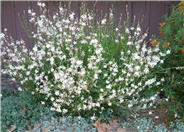
Common name:Gaura
Botanical name:Gaura lindheimeri
Gaura is a lovely addition to a perennial border, with its fine green foliage and delicate white to pink flowers. The plant has an open vase shape, and grows about 36 inches tall and 24 to 36 inches wide. Leaves are fine, green, and sometimes spotted with maroon. Flowers are arrayed on long stems and are reminiscent of butterflies; the blooms open from the bottom of the stems towards the top, over a long season of bloom (early summer to fall). Its airy quality creates movement in the garden. Combines well with other perennials and ornamental grasses. A number of named cultivars are now available, some with more distinctively pink flowers or variegated foliage.
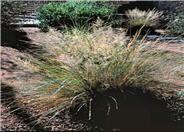
Common name:Bull Grass
Botanical name:Muhlenbergia emersleyi
This Muhlenbergia is a cool season, clumping grass with blue-green, course foliage. It grows about 2 to 3 feet tall and wide. Its plume emerges late summer and is purple, though it turns a silvery white as the season progresses. The whole plant turns tan with the first hard frost. A southwest native, it is very heat and drought tolerant once established.
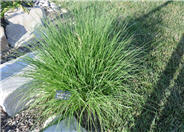
Common name:Fountain Grass
Botanical name:Pennisetum alopecuroides
Fountain grass is a group of warm-season, clumping grasses with graceful forms and early plumes. Foliage is fine-textured and green, with the leaves 1/4 to 1/2 inch wide and up to 30 or so inches long. The form is dense, upright, and mounded, growing from 1 to 3 feet tall and wide, and a little taller while in bloom. Fountain grass tend to bloom before Miscanthus and Panicums, usually by mid-July. Flowers are fox-tail-like and plump, and range in colors from white, cream, pinks, to nearly black. Flowers tend to shatter, but foliage persists into winter.
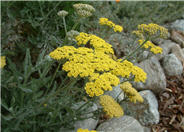
Common name:Moonshine Yarrow
Botanical name:Achillea 'Moonshine'
'Moonshine' is an upright, clump-forming, compact hybrid yarrow, with deeply-dissected, fern-like, aromatic, silvery to gray-green foliage. Flowers are long-lasting, bright lemon-yellow, and bloom throughout the summer on stiff, erect stems. This plant resembles A. 'Coronation Gold' except it is much smaller and the flowers are a lighter yellow. Grows about 18 inches tall and 24 inches wide, and seems to be slightly less invasive then other yarrow, keeping a more clumping habit. A great addition to a sunny perennial border.
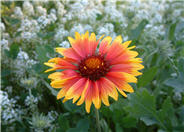
Common name:Blanket Flower
Botanical name:Gaillardia x grandiflora
Blanket flowers are a long-time favorite for hot, dry perennial gardens and meadows. The flowers are daisy-like, with an ombre-like color arrangement from yellow to orange to maroon, though many modern cultivars are single-colored. Eyes range from brown, to maroon, to yellow, depending on the cultivar. Leaves are green to grey green, and either oval to oblong, slightly toothed to deeply lobed. Size varies with cultivars, between 12 to 36 inches tall and 18 to 30 inches wide. Companions well with salvia, agastache, and lavender.
| Designer: Dr. Condie | Dr. Condie 14 |
Photographer: GardenSoft |
Water Saving Tip:
Even though it's hot, your lawn only needs to be watered twice a week to stay healthy.
And don't water the whole lawn for a brown spot—drag out a hose.
